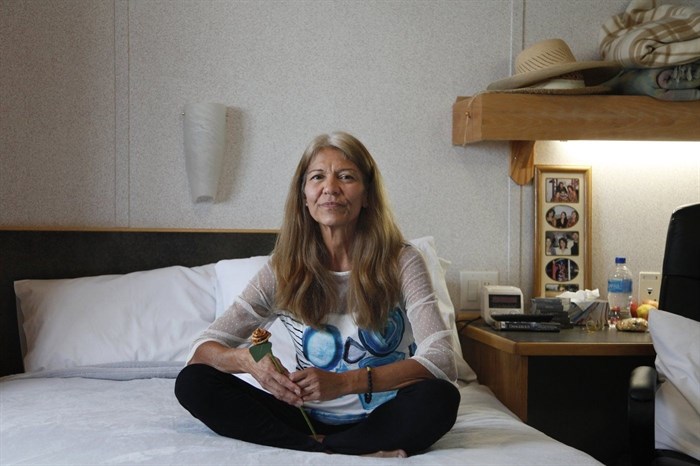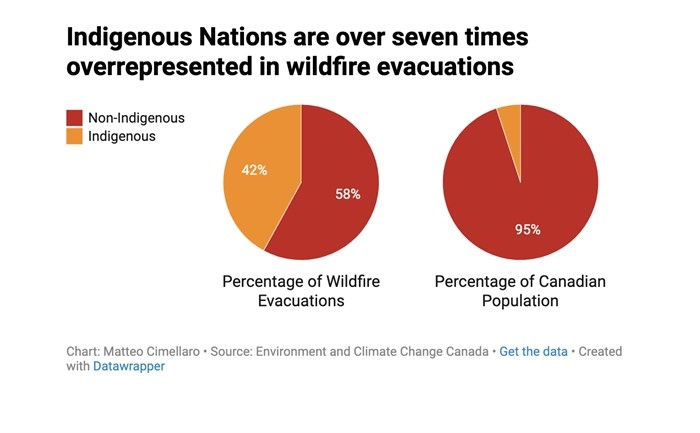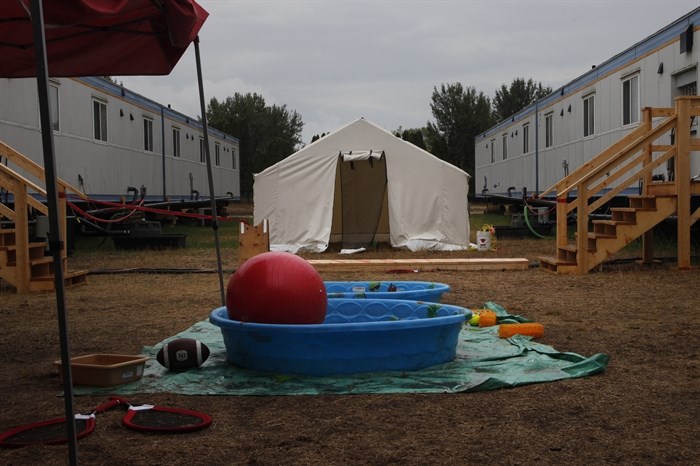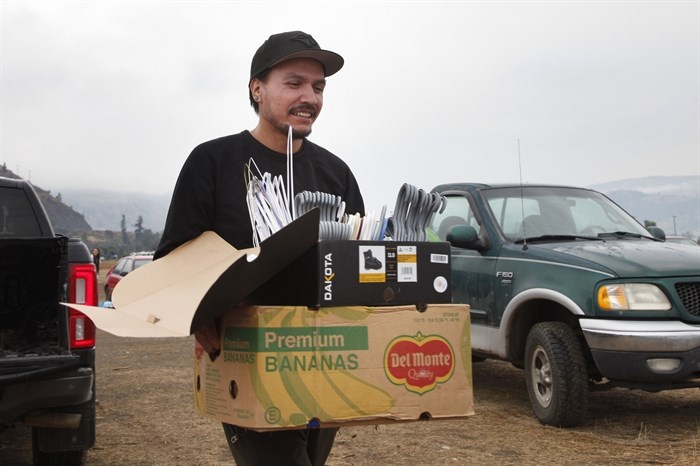
A portrait of Debbie Rupke (Tomma), who was evacuated alongside other Skwlax te Secwepemcu´l?ecw community members in August.
Image Credit: Jen Osborne
September 17, 2023 - 9:00 AM
Debbie Rupke (Tomma) heard a rattle at her door. It was her cousin in a panic, telling her they had only minutes to leave. Strong winds had shifted, and a nearby wildfire was bearing down on their homes. Rupke (Tomma) had returned from Vancouver the day before, so she grabbed her yet-to-be-unpacked suitcase and her most precious memento: a family portrait of her daughter she gave up for adoption at 15.
Rupke (Tomma)’s cousin needed help. Immediately. Her vehicles and house were directly in the path of the flames.
Rupke (Tomma) borrowed a vehicle from a fellow Skwlax te Secwepemcúl?ecw community member, picked up her son with only the clothes on his back and started to drive.
Water bombers circled overhead, dropping what they could in an effort to control a fire that refused to be tamed.
Outside, everybody was throwing their belongings into their vehicles.
“It was a total disaster. Massive, massive confusion,” she told Canada’s National Observer.
She gassed up at the local gas station and escaped to the safety of an evacuation camp. That gas station is now one of at least 31 structures that burned and will have to be rebuilt.
Later, it sunk in how close a call it had been. Rupke (Tomma) only has a landline, and the evacuation order was sent to Skwlax members’ cellphones. For Rupke (Tomma), there was no warning until the knock on her door. “It just happened — just like that.”

Debbie Rupke saved this photo frame from her home during the evacuation.
Image Credit: Jen Osborne
Fleeing fire
Orange skies, sudden evacuations, burnt buildings and choked lungs. In Canada’s biggest cities, the realities of the climate crisis appeared and disappeared like a smoke plume this summer, mitigated with masks and air purifiers. However, for First Nations, many in rural and remote places, the increasing intensity of wildfires has meant increased evacuations and weeks of unhealthy smoke. In the most devastating fires, people in First Nations lose homes and cherished family possessions, like photographs of loved ones and medicine bags.
Canada’s National Observer has spent the summer tracking how the country’s worsening wildfire seasons have affected First Nations over the past decade. Indigenous people are often most vulnerable to wildfires due to the remoteness of many communities and their location in wildfire-prone zones. While many news organizations have charted the size and location of the fires, Canada’s National Observer is the first to map the disproportionate human cost of the crisis on First Nations using media coverage and Indigenous Services Canada (ISC) data.

Image Credit: The Tyee
We found over 90 First Nations have been evacuated due to wildfires since May, more than during the four previous fire seasons combined, according to data collected from ISC.
The previous worst fire season for First Nation evacuations was in 2021 when 56 nations were evacuated, and this year’s fire season is not over yet.
Climate change does not impact people in the same way, said McGill University climate researcher Mohammad Reza Alizadeh. Environmental and climate injustice places a disproportionate burden on First Nations when wildfires strike. Indigenous Peoples have fewer resources and less robust infrastructure than non-Indigenous communities and are impacted by climate disasters at a higher rate, according to his own research.
“The people with less resources, less infrastructure, such as Indigenous communities, are affected [by wildfires] even more than the people that do have access to resources,” he said.
The federal government recognizes the disproportionate impact of wildfires on First Nations. According to Ottawa's recently published Adaptation Action Plan, First Nations experience 42 per cent of wildfire evacuations while only representing five per cent of the population.

Image Credit: The Tyee
Several Indigenous communities have faced multiple evacuations over the past 10 years. At least three have been evacuated five times in the last decade, including Lytton First Nation, Peter Ballantyne First Nation and Lac La Ronge Indian Band. All three of these communities were forced to flee in 2023.
In the Northwest Territories, Chief April Martel of Kat’lodeeche First Nation has evacuated her community twice this fire season. She said the season started so early this year that the territory’s Department of Environment and Climate Change was not ready when a wildfire roared through the community on Mother’s Day.
Typically, fire season in the territory arrives at the end of May, Martel said, not the beginning, so none of the equipment was ready. Water bombers in Yellowknife had electrical problems due to the 28 C heat, and territorial helicopters with water buckets weren’t operational yet, either, she said.
Chief Martel called for an immediate evacuation to the adjacent town, Hay River, on the morning of May 12. By evening, everyone was forced to flee Hay River as well when the fire jumped the river. Several homes burned down in Kat’lodeeche that night. And when people were allowed to return on June 7, there was still one more evacuation to come.
During the second evacuation, approximately 68 per cent of the Northwest Territory’s residents, including Kat’lodeeche First Nation, were evacuated. Dene community members from Kat’lodeeche and other First Nations were scattered across the western provinces, many in Alberta, British Columbia and Manitoba.
National Dene Chief Gerald Antoine sympathized with the displacement of families from the wildfire crises at an August press conference. National Chief Antoine drew from his experiences as a child in residential school and the foster care system, pointing out that displaced families have done nothing wrong to cause their relocation.
“That's a situation or community families are going through right now, and thinking about it in the context of family is important,” Antoine said.

The children's yard at Tsellétkwe Lodge.
Image Credit: Jen Osborne
In Quebec, almost all of the nine communities of the Cree Nation government were evacuated this year, Leeroy Blacksmith, fire marshal for the Cree Nation government, said. Residents were forced to leave for various reasons, including fire predictions, smoke intensity and, in some cases, the sheer speed and proximity of an uncontrollable fire.
In Oujé-Bougoumou, for example, the fire was so fast that even Quebec’s forest firefighting organization, La Société de protection des forêts contre le feu (SOPFEU), could not handle the blaze. When the fire was 20 kilometres away and the wind picked up, a state-of-emergency evacuation was called, Blacksmith explained.
Evacuations for First Nations can also be complex, particularly when roadways are threatened. On Aug. 16, during an evacuation of Wemindji, located in northeastern Quebec on James Bay, the fire compromised the one access road out of the community, so five planes were summoned to evacuate community members. Pilots faced crosswinds of 40 to 50 kilometres an hour, making it difficult to land, but everyone got out safely, Blacksmith added.
A ‘timeless’ day
James Tomma, Kúkpi7 (Chief) of Skwlax te Secwepemcu´l?ecw, describes the day of his community’s evacuation as “timeless.”
There is a term used by the Skwlax te Secwepemcu´l?ecw to describe the forces that drive wildfires.
“In our culture, we call it fire people,” Tomma said. “And they wanted to dance that day, and they weren’t going to be denied.”
Tomma initially planned to stay back and battle the flames. He is a veteran firefighter who fought his first fire in 1978. But that day, the fire people, dancing with the wind people, were too strong.
Kúkpi7 (Chief) Tomma, 63, and his older brothers readied themselves to take a stand at their mother’s house. Or so they thought. “But no, the fire just came, and it was roaring and the wind was whistling,” he said.

Dustin A. Tomma, camp manager at the Tsellétkwe Lodge evacuation camp, takes coat hangers into the clothing donation tent at the evacuation centre in the Kamloops area.
Image Credit: Jen Osborne
Luckily, the fire was still 50 yards away from the river. The brothers soaked themselves with river water and were eventually picked up by community members in a boat.
That night, Tomma slept in his parked truck beside his wife before going to the evacuation camp the next day, relieved his wife had made it to safety.
The fire took their house and destroyed all the photos of their late son and other family members.
“You know, we have to come to grips with that,” he said.
Amid incredible personal loss, Kúkpi7 (Chief) Tomma has little time to grieve. He’s in endless meetings with ISC, the B.C. government and other partners. He hosts a weekly town hall for his community to soothe growing anxieties. He promises they will rebuild.
“My house won't be rebuilt until the last band member can open a door and close it behind them and say they’re home,” he said.
But for Skwlax te Secwepemcu´l?ecw evacuees, time has taken on an unusual quality.
Kúkpi7 (Chief) Tomma has found himself losing track, unable to tell the days and hours. His assistant reminds him when and where he has to be. It’s the same at the Tsellétkwe Lodge, the evacuation camp housing around 35 community members: those who have been evacuated are losing sense of the hours and days.
Everything has slowed, lost to the shock of the evacuation, Dustin Tomma, camp manager at Tsellétkwe Lodge, said.
“You seem to lose time here,” said Tomma, who is working around the clock corralling donations and helping with activities for the kids. “It kind of feels like we're on a camp vacation, kind of; it feels weird here.”
A changing, extreme climate causes tinderbox conditions
About 15.3 million hectares have burned this season alone, which is larger than the state of New York, according to Natural Resources Canada. Experts have told Canada’s National Observer this fire season is projected to continue into the fall and could even survive through the winter under frozen ground.
In a recent paper published by World Weather Attribution, an international collaboration of scientists who study how climate change and extreme weather events interact, researchers found the climate crisis made the likelihood of the devastating wildfire season in Quebec at least twice as likely, and the intensity of the fires at their peak at least seven times more likely.
This year’s weather created a tinderbox across the country. In Quebec, B.C., Alberta and the Northwest Territories, among other places, the early spring thaw dried vegetation, setting the stage for the worst wildfire season on record, according to several sources Canada’s National Observer interviewed.
On the land, in Cree Nation territory in northern Quebec, Blacksmith said the characteristic rivers and swamp dried up. The territory usually drips with thick boreal forest and wet, porous muskeg. This year, the moss is “dry like overcooked bacon.” Conditions are so bad, wildfires have burned through its top layer, exposing the deep roots of blackened, old-growth trees.
In B.C., Kúkpi7 (Chief) Tomma described the conditions on Skwlax territory as “prepping for the perfect storm,” noting the area has been at drought Level 5, the province’s highest, for weeks.
“Everything was tinder dry … there was nothing that was going to stop this,” he said.
A community’s tragedy is a time to reflect
On the summer days before the fire, you might have found Debbie Rupke (Tomma) on her back porch watching and taking care of the wildlife. She would leave water and some food for birds, a raccoon and squirrels. At first, it was two squirrels, but as the flora dried and the smoke worsened, more arrived at her house for refuge. They would climb up and eat the seeds in her sunflowers or wait for strawberries to ripen on the bush.
Now, while Rupke (Tomma) waits at the Tsellétkwe Lodge evacuation camp, she wonders about her four-legged friends.
“Since my place survived, I know they would live by my place,” she said. “I know it’s a safe place for them.”
But it’s not just her four-legged friends she worries about. When everyone is allowed to return home, Rupke (Tomma) and Dustin Tomma said they will open their doors to their community.
While the losses cannot be ignored, there are lessons to learn from the tragedy, Dustin Tomma said. The fire people took everything “to remind us that it's just materials, and that community is stronger than materials,” he explained, reflecting on a video of an Elder he had watched in the aftermath.
“Now, it's going to teach us how to be a community again.”
— This story was originally published by Canada’s National Observer
— Funding from the North Family Foundation contributed to the delivery of this story.
News from © iNFOnews, 2023